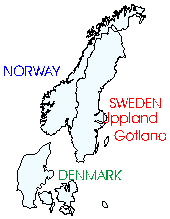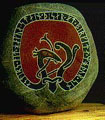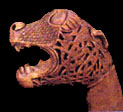Runestones
Where Do You Find Runestones?
Most people associate runestones with Scandinavia and Vikings. That's correct but the custom to make runestones is much older than that. The runestones were raised during 400 AD - 1100 AD however majority of them date back to the Viking Age, 800 AD - 1050 AD. Runestones that are a type of memorial are typical of Scandinavia and especially Sweden that has the most runestones in the world, more than 3500 by now. The runes were not used only on stone but also on wood, iron, bone and other materials. In fact we must assume that runes were used more often on other materials than stone but what's left today are the stones with their inscriptions
The total number of known runic inscriptions is probably more than 5000, the majority of them in Sweden and the landscape of Uppland. Almost every year some new runestones or parts of runestones turn up in Sweden. In Norway there are also a lot of runestones, more than 1000 and Denmark has some 700 runestones. Iceland has about 60 stones, most of them from late times. The Viking travelled a lot and there are also runic inscriptions and/or runestones from Greenland, the Faroes, Isle of Man, the Orkneys, Shetlands, Ireland, the Western Isles and one in Russia. Outside these "northern regions" runic inscriptions are comparatively rare.
Why raising runestones
The first "real" runestones were raised during the 6:th century however there is a stone slab with runes on it, which date back to the 400 AD. The stone is a part of a grave found on the island Gotland and was never mend to be seen. On that stone slab someone as cut the whole Old Norse rune row. We must guess that the rune row should protect the buried person in some way. Many of the oldest runic inscriptions are associated with magic, mysterious and sorcery.
The runes had or still have? (you never know) a magic side beside their function as an alphabet. But the majority parts of them were originally made of other reasons. We don't quit know all of them but there are several conceivable possibilities. One reason was to show everyone that you were a free, rich and significant man that could afford a runestone. The stones give us a glimpse of early kings and powerful men during the past, however "ordinary" people also had their runestones raised for them. There are runestones that tell about Vikings expeditions and Viking raids in Great Britain, France, Russia, Greece, Germany and other countries. The most common thing to write on a runestone was after all just to raise a stone for his dead father, son, mother, brother, daughter or sister.
But for sure you don't have to be dead to have your own runestone. Some runestones was probably raised of other reasons. On some stones you can read the familynames back in several generations. Who was married to who and who inherited the farm and the land and so on. These runestones must be some kind of certificate of registration of title. This is my farm and my property. Keep away from it!
Some other famous runestones of that type is a couple of stones some 30 km north of Stockholm in Täby. A man, Jarlabanke, raised these stones when he still was a life as the stones say. He also let us know that he himself own the entire district Täby which today is a rather large municipality with some 60000 inhabitants.
The men and women behind the stones
Who
were the men and women behind the runestones? Well let's think about one
of the parts; the rune cutter. In the landscape of Uppland there are about
1200 runestones. Some 600 of them could be connected with about 20 rune
cutters. What's left is a bunch of people, amateurs, apprentices and masters
all over the country. The great masters, who did runestones for living,
were probably not so many. Some of them has however become undying masters;
Öpir, Livfot, Åsmund Kåresson, Balle to mention some
of them. Things was not so much better in the old day's, so probably we
can trace some rascals among these people. It seems like it was very important
to have your own runestone because there are some ancient falsifications.
For example there are a couple of runestones north of Uppsala which look
like ordinary one's but the runes on them are just nonsense. We must guess
that not everyone could read the runes so the falsifier could probably
get away without any reprisals. Or perhaps the farmer made the stone himself?
The stone were originally painted
When
you travel thru Sweden and especially Uppland you are able to see a lot
of runestones. The very majority of them still stand in their originally
place. However many of them are not so easy to get in sight thru the car
window because you see stones everywhere. In the past days it was much
easier. The runestones were originally painted and we know that several
colours were used; black, red, blue, white, yellow. We know it because
some runestones have been found with their paint left and some inscriptions
tell us the names of the guy who cut the runes and the name of the one
who painted them. It's easy to understand that the runestones were painted
when you see one painted. The motive is much easier to see and there is
no problem for you to read the runes, and that was the whole point with
them. Just see them as a type of neon signs of that time. People wanted
them to be seen and the best point in the landscape was to raise them
along waysides, rivers and other important points in the landscape as
a wade.




![]()
